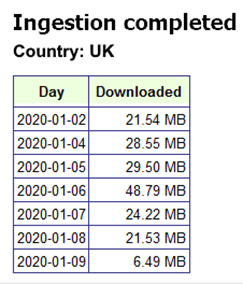
-
11 December 2020
- Databricks
Capture Databricks’ cells truncated outputs
When we run a Databricks’s cell within the Azure environment, we usually get some output from the cell. It can look like this:

Most often we will not encounter an issue with such an approach. Unfortunately, there are cases, when Databricks will remove some parts of the output. It will happen when our script will generate hundreds of lines in the output. If a size of such long output will exceed Databricks’s threshold (estimated limit: 128 kB), the notebook will return truncated output. When the output is not carrying important information – we might be okay with that. At other times – we might need to extract some valuable information from the output and the truncation will ruin the effects of our script or will prevent us from knowing the actual output of the notebook.
In our case, we hit upon this issue when executing large ingestion jobs connecting to Planorama API and Salesforce API. Below we can see an example of a truncated output:
 Our output was returning hundreds of lines of output but only a few lines were meaningful. We wanted to extract three pieces of information: country code, day, and download size for that country and day. Below is an example of the output containing these pieces of information:
Our output was returning hundreds of lines of output but only a few lines were meaningful. We wanted to extract three pieces of information: country code, day, and download size for that country and day. Below is an example of the output containing these pieces of information:
 The solution to the problem of truncated output is placing somewhere within our script a code-snippets for:
The solution to the problem of truncated output is placing somewhere within our script a code-snippets for:
- intercepting all the output,
- parsing this output and storing aside the information we need
- finally showing an HTML report.
Using the HTML for a report is a valuable hack providing us with an extra method of showing information under a cell that won’t be truncated by Databricks.
Need help with Databricks? Check our Data Engineering Services and see how we can help your business
How to hack truncated outputs problem with HTML, 3-step process:
1. Intercepting the output
The first thing we need to do is to place the below code, somewhere before the main script starts:
from IPython.utils.capture import CapturedIO
capture = CapturedIO(sys.stdout, sys.stderr)this will prepare a variable capture (with a property stdout) which will contain the cell’s output. Later we can refer to this variable’s properties whenever we want to check the current output.
We also prepare an additional list for storing the output during the ingestion’s progress:
WholeOutput = []
2. Parsing the output and storing the information
In this step, using the aforementioned variable capture.stdout, we are able to parse the output and extract meaningful information. In our case we used the script (crucial variables were blue-highlighted) which was injected in the ingestion loop (thus: WholeOutput.extend):
def simplified_log(log):
return [i for i in log.splitlines() if 'Downloaded' in i \
or 'Ingestion start' in i]
# browse through the OUTPUT and get download sizes for the report:
key, report = '', {}
WholeOutput.extend(simplified_log(capture.stdout))
for l in WholeOutput:
l = re.sub(r".*?\+\+Ingestion start: ", "*", l)
# extract CountryCode (1:3) and date (4:14)
if l.startswith('*'): key = l[1:3] + ' - ' + l[4:14]
if "INFO – Downloaded:" in l:
# cut the string removing only download size
l = re.sub(r".*?root - INFO - Downloaded: (.*)", r"\1", l)
report[key] = l.strip() # store only the download size
3. Showing the report
The final stage is showing the HTML report – as mentioned before – this method is an independent form of outputting the information under an individual cell and Databricks truncating the output will not tamper with our report.
Our project used the below, simple function for showing the report:
def showReport(self):
html = ['''<!DOCTYPE HTML><BODY>
<h2>Ingestion completed </h2> <p> COUNTRY: <b>{} </b></p>
<table><tr><th>Date</th><th>Downloaded</th></tr>'''.format \
(", ".join(self.countries).upper())]
for key in list(self.report.keys()).sort():
size = self.report[key]
html.append("<tr><td>" + key + '</td><td>' + size + "</td>")
html.append("</table> </BODY> </HTML>")
displayHTML("\n".join([x for x in html if type(x) != type(type)]))The above method produces the report, which is shown at the end of each loop iteration – giving us frequent feedback on the ingestion progress:
 Visit our blog for more in-depth Data Engineering articles:
Visit our blog for more in-depth Data Engineering articles:


